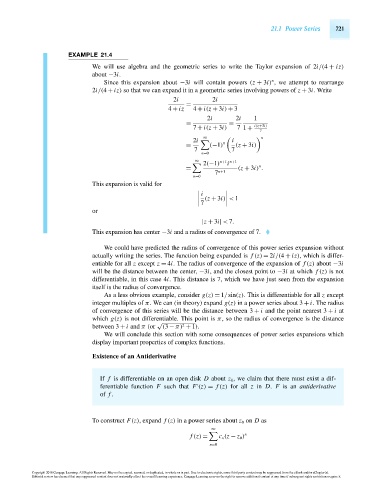Page 741 - Advanced_Engineering_Mathematics o'neil
P. 741
21.1 Power Series 721
EXAMPLE 21.4
We will use algebra and the geometric series to write the Taylor expansion of 2i/(4 + iz)
about −3i.
n
Since this expansion about −3i will contain powers (z + 3i) , we attempt to rearrange
2i/(4 + iz) so that we can expand it in a geometric series involving powers of z + 3i. Write
2i 2i
=
4 + iz 4 + i(z + 3i) + 3
2i 2i 1
= =
7 + i(z + 3i) 7 1 + i(z+3i)
7
∞
2i i n
= (−1) n (z + 3i)
7 7
n=0
∞ n+1 n+1
2(−1) i
n
= (z + 3i) .
7 n+1
n=0
This expansion is valid for
i
(z + 3i) < 1
7
or
|z + 3i| < 7.
This expansion has center −3i and a radius of convergence of 7.
We could have predicted the radius of convergence of this power series expansion without
actually writing the series. The function being expanded is f (z) = 2i/(4 + iz), which is differ-
entiable for all z except z = 4i. The radius of convergence of the expansion of f (z) about −3i
will be the distance between the center, −3i, and the closest point to −3i at which f (z) is not
differentiable, in this case 4i. This distance is 7, which we have just seen from the expansion
itself is the radius of convergence.
As a less obvious example, consider g(z) = 1/sin(z). This is differentiable for all z except
integer multiples of π. We can (in theory) expand g(z) in a power series about 3 + i. The radius
of convergence of this series will be the distance between 3 + i and the point nearest 3 + i at
which g(z) is not differentiable. This point is π, so the radius of convergence is the distance
√
2
between 3 + i and π (or (3 − π) + 1).
We will conclude this section with some consequences of power series expansions which
display important properties of complex functions.
Existence of an Antiderivative
If f is differentiable on an open disk D about z 0 , we claim that there must exist a dif-
ferentiable function F such that F (z) = f (z) for all z in D. F is an antiderivative
of f .
To construct F(z), expand f (z) in a power series about z 0 on D as
∞
n
f (z) = c n (z − z 0 )
n=0
Copyright 2010 Cengage Learning. All Rights Reserved. May not be copied, scanned, or duplicated, in whole or in part. Due to electronic rights, some third party content may be suppressed from the eBook and/or eChapter(s).
Editorial review has deemed that any suppressed content does not materially affect the overall learning experience. Cengage Learning reserves the right to remove additional content at any time if subsequent rights restrictions require it.
October 14, 2010 15:35 THM/NEIL Page-721 27410_21_ch21_p715-728

